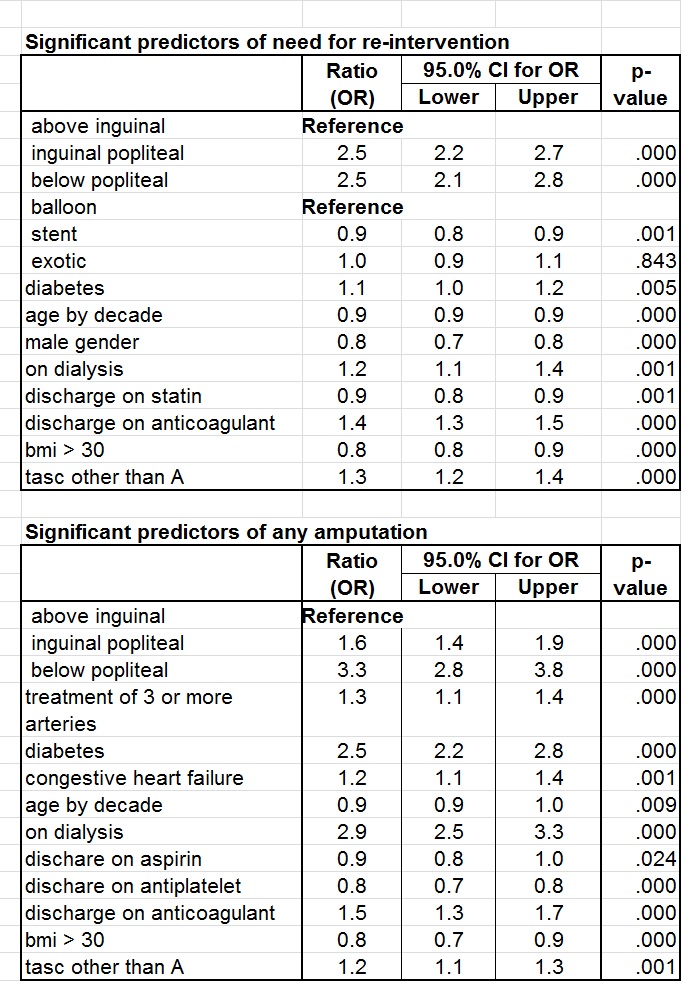Predictors of secondary interventions in patients underwent peripheral interventions for peripheral vascular disease
Albeir Mousa, MD.,FACS., RPVI.,MPH.,MBA1, Mike Broce, BA2, Ramez Morkous, MD1, Michael Yacoub, MD,FACS,RPVI1, Gilbert Upchurch, Jr., MD,FACS3, Ali AbuRahma, MD.,FACS., RPVI.,RVT1.
1West Virginia Univeristy, Charleston, WV, USA, 2CAMC Research Institute, Charleston, WV, USA, 3UVA, Charlottesville, VA 22908, WV, USA.
0 0 1 321 1834 WVU 15 4 2151 14.0 Normal 0 false false false EN-US JA X-NONE /* Style Definitions */ table.MsoNormalTable {mso-style-name:"Table Normal"; mso-tstyle-rowband-size:0; mso-tstyle-colband-size:0; mso-style-noshow:yes; mso-style-priority:99; mso-style-parent:""; mso-padding-alt:0in 5.4pt 0in 5.4pt; mso-para-margin:0in; mso-para-margin-bottom:.0001pt; mso-pagination:widow-orphan; font-size:14.0pt; font-family:"Times New Roman"; mso-bidi-font-family:"Times New Roman"; mso-bidi-theme-font:minor-bidi; color:black; mso-themecolor:text1;} Objectives: Many available percutaneous interventions (PI) options are currently available for patients with peripheral vascular disease. Although outcomes are often dependent on many anatomic and disease factors, yet predictors of outcomes are not well characterized. This study is to examine predictors of secondary interventions after PI in large registry to provide a glimpse on real world practice. Methods Data of Virginia’s group Vascular Quality Initiative (VQI) database registry was analyzed in blind fashion. Primary outcome was the need for re-intervention defined as having an assisted procedure +/- secondary procedure. Secondary outcomes included major adverse limb event and freedom from amputation (FFA). Kaplan Meier and multivariate Cox Regression was used to determine significant independent predictors of events (2nd intervention +/-amputation). Results Database was obtained from January 2010 through September 2014. Procedural and follow-up data was available for 15,527 cases. Mean age of 67.3 + 11.0 years, with male patients 58.5%. Need for re-intervention was significantly higher with balloon (22.7%) or Laser (24.8%) procedures as compared to stents (13.8%), p<0.001. Likewise, amputations was significantly higher with balloon (12.4%) or laser (11.0%) compared to stents (7.8%), p<0.001. Need for re-intervention was significantly higher for procedural locations inguinal to popliteal (25.2%) and below popliteal (26.2%) as compared to above the inguinal (10.4%), p<0.001, while the percentages for any amputations was inguinal to popliteal (10.9%) and below popliteal (28.6%) as compared to above the inguinal (5.7%), p<0.001. Other significant predictors include diabetes, Statin and male gender (see table 1 for significant predictors). All four Kaplan Meier curves (location and treatment by re-intervention and by FFA indicated a significantly better outcomes for above inguinal and stent procedure (all p<0.001). Conclusions This study suggests that stents, above inguinal and statin use are associated with decrease re-interventions after PI. This should be considered to guide therapy before consideration for PI. <!--EndFragment-->

Back to 2017 Program




